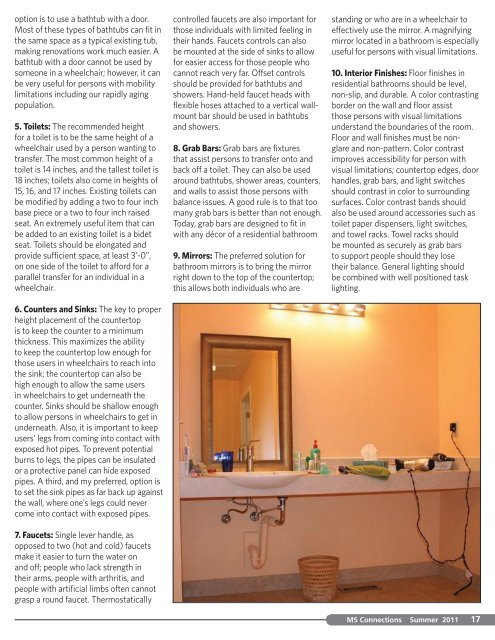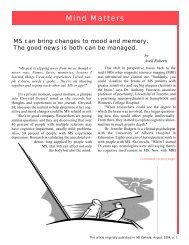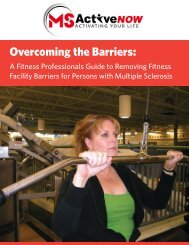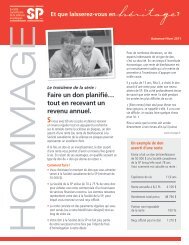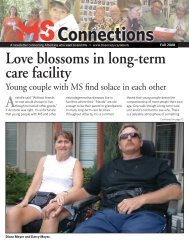Summer 2011 - Multiple Sclerosis Society of Canada
Summer 2011 - Multiple Sclerosis Society of Canada
Summer 2011 - Multiple Sclerosis Society of Canada
Create successful ePaper yourself
Turn your PDF publications into a flip-book with our unique Google optimized e-Paper software.
option is to use a bathtub with a door.<br />
Most <strong>of</strong> these types <strong>of</strong> bathtubs can fit in<br />
the same space as a typical existing tub,<br />
making renovations work much easier. A<br />
bathtub with a door cannot be used by<br />
someone in a wheelchair; however, it can<br />
be very useful for persons with mobility<br />
limitations including our rapidly aging<br />
population.<br />
5. Toilets: The recommended height<br />
for a toilet is to be the same height <strong>of</strong> a<br />
wheelchair used by a person wanting to<br />
transfer. The most common height <strong>of</strong> a<br />
toilet is 14 inches, and the tallest toilet is<br />
18 inches; toilets also come in heights <strong>of</strong><br />
15, 16, and 17 inches. Existing toilets can<br />
be modified by adding a two to four inch<br />
base piece or a two to four inch raised<br />
seat. An extremely useful item that can<br />
be added to an existing toilet is a bidet<br />
seat. Toilets should be elongated and<br />
provide sufficient space, at least 3’-0”,<br />
on one side <strong>of</strong> the toilet to afford for a<br />
parallel transfer for an individual in a<br />
wheelchair.<br />
6. Counters and Sinks: The key to proper<br />
height placement <strong>of</strong> the countertop<br />
is to keep the counter to a minimum<br />
thickness. This maximizes the ability<br />
to keep the countertop low enough for<br />
those users in wheelchairs to reach into<br />
the sink; the countertop can also be<br />
high enough to allow the same users<br />
in wheelchairs to get underneath the<br />
counter. Sinks should be shallow enough<br />
to allow persons in wheelchairs to get in<br />
underneath. Also, it is important to keep<br />
users’ legs from coming into contact with<br />
exposed hot pipes. To prevent potential<br />
burns to legs, the pipes can be insulated<br />
or a protective panel can hide exposed<br />
pipes. A third, and my preferred, option is<br />
to set the sink pipes as far back up against<br />
the wall, where one’s legs could never<br />
come into contact with exposed pipes.<br />
7. Faucets: Single lever handle, as<br />
opposed to two (hot and cold) faucets<br />
make it easier to turn the water on<br />
and <strong>of</strong>f; people who lack strength in<br />
their arms, people with arthritis, and<br />
people with artificial limbs <strong>of</strong>ten cannot<br />
grasp a round faucet. Thermostatically<br />
controlled faucets are also important for<br />
those individuals with limited feeling in<br />
their hands. Faucets controls can also<br />
be mounted at the side <strong>of</strong> sinks to allow<br />
for easier access for those people who<br />
cannot reach very far. Offset controls<br />
should be provided for bathtubs and<br />
showers. Hand-held faucet heads with<br />
flexible hoses attached to a vertical wallmount<br />
bar should be used in bathtubs<br />
and showers.<br />
8. Grab Bars: Grab bars are fixtures<br />
that assist persons to transfer onto and<br />
back <strong>of</strong>f a toilet. They can also be used<br />
around bathtubs, shower areas, counters,<br />
and walls to assist those persons with<br />
balance issues. A good rule is to that too<br />
many grab bars is better than not enough.<br />
Today, grab bars are designed to fit in<br />
with any décor <strong>of</strong> a residential bathroom<br />
9. Mirrors: The preferred solution for<br />
bathroom mirrors is to bring the mirror<br />
right down to the top <strong>of</strong> the countertop;<br />
this allows both individuals who are<br />
standing or who are in a wheelchair to<br />
effectively use the mirror. A magnifying<br />
mirror located in a bathroom is especially<br />
useful for persons with visual limitations.<br />
10. Interior Finishes: Floor finishes in<br />
residential bathrooms should be level,<br />
non-slip, and durable. A color contrasting<br />
border on the wall and floor assist<br />
those persons with visual limitations<br />
understand the boundaries <strong>of</strong> the room.<br />
Floor and wall finishes must be nonglare<br />
and non-pattern. Color contrast<br />
improves accessibility for person with<br />
visual limitations; countertop edges, door<br />
handles, grab bars, and light switches<br />
should contrast in color to surrounding<br />
surfaces. Color contrast bands should<br />
also be used around accessories such as<br />
toilet paper dispensers, light switches,<br />
and towel racks. Towel racks should<br />
be mounted as securely as grab bars<br />
to support people should they lose<br />
their balance. General lighting should<br />
be combined with well positioned task<br />
lighting.<br />
MS Connections <strong>Summer</strong> <strong>2011</strong> 17


